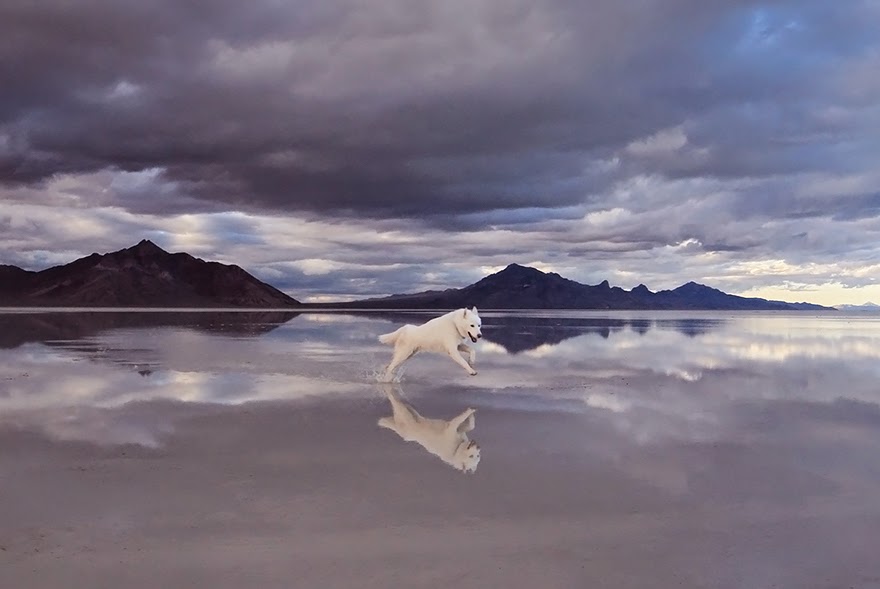Foodies are great
people to buy gifts for because there are just in various different amazing
gifts you could get them and that's why without even delving into the world of
edible treats. These wonderful food-themed gifts are flawless for anyone who
loves spending time in kitchens or restaurants. There’re plenty of brilliant
food-related product designs out there because there’re tons of brilliant tools
that make working in the kitchen or serving food at ease or more fun. If you have
any great ideas that should be on this list, feel free to add them in our list and
vote for your favorites!
Tuesday, 23 December 2014
Friday, 19 December 2014
Stunning Collections of GIF's
An animated GIF (Graphics Interchange
Format) file is a graphic image on a Web page that moves for example, a
twirling icon or a banner with a hand those waves or letters that
magically get
larger. What does GIF mean? GIF is an acronym, abbreviation or slang
word that
is explained above where the GIF definition is given. Nature is perfect
to create Gif's and it always inspiring peoples. Here's the collection
of some exceptional Gif's.Source: Charismatic Planet
Labels:
Gif
Thursday, 18 December 2014
Garden visiting Green Finches
The greenfinch is the largest of
a trio of British finches with partly green plumage (the others are the siskin
and the rare serin). It is one of our more numerous birds, being well suited to
our lowland countryside with its mosaic-like pattern of woods, farmland,
hedgerows, thickets and gardens.
The greenfinch is one of the most
widespread and abundant visitors to bird tables in Britain and Ireland. It is
sometimes disparaged by birdwatchers who are captivated by the acrobatic feats
of the blue and great tits as they hang on to strings of nuts. The greenfinch
being a relatively large finch is not a particularly acrobatic feeder although,
in several areas, it has learned to feed on hanging nuts. Some people actually
overlook its presence since it is similar in size to the ubiquitous house
sparrow, and many greenfinches have rather little yellow or green on their
plumage which strengthens the resemblance. The adult male greenfinch is a
handsome bird, with brilliant yellow flashes on the wings and tail-most obvious
when in flight and washes of green and greenish yellow over the rest of the
plumage. The female and the young of either sex are less highly colored, with
much brown streaked plumage like a sparrow’s. In recent years another much
smaller finch, the siskin, has also taken to feeding in gardens, mostly at the
end of winter, but there is little chance of the two being confused.
Habitat and Range
As with many of our garden and
farmland bird species, greenfinches are naturally birds of the woodland edge,
finding hedges in arable land, and shrubberies in parks and gardens, ideal
places for breeding. They can be found over most of Europe, spreading into Asia
in the east and to north Africa in the South, but they’re absent from the far
northern parts of Europe and Asia, which lack trees of shrubs. Many areas in
Britain have reported recent spreads in the breeding range and local increase
in numbers.
Seed Eaters
Greenfinches feed on seeds for
almost all their lives. In the autumn the flocks of young birds, which are soon
joined by the adults, may become very numerous, with some numbering in the
thousands. These large flocks are sometimes seen feeding on ripening corn,
gleaning the stubbles or feasting on weed seeds in root crops or on waste
ground. Their weight generally precludes feeding from seeds still held on the
plants, but they are adept at finding seeds on the ground. They can live well
on open ploughed land, finding dormant seeds which may, in some cases, be
several years old. The weeds
particularly favored include charlock, persicaria, groundsel, chickweed and fat
hen. When a large flock has found a good feeding site, it is quite possible to
hear the birds from thirty to forty years away not from their calls but from
the cracking of seeds in their bills. All the food is first manoeuvred in the
bird’s beak to remove the husk for greenfinches only eat the central nutritious
part.
Autumn and winter
The autumn flocks frequently
contain other finch species, but during the evening the greenfinches tend to
roost on their own. The roosting site is often a clump or rhododendrons,
laurels or an old hedge with plenty of holly or ivy. The birds prefer roosting
sites which are not particularly high but have plenty of thick cover. Ringing
results have shown that the birds move regularly from roost to roost and that
in general they are a mobile and nomadic species. There are not many
indications of movements over 200 or 300 km within the British population, but
many birds from the northern part of the European range travel 1000km or more
each autumn and spring. In cold winter weather is not a serious threat to
survival provided that the feeding grounds are clear of snow. If the weather is
very cold and the day length is very short, they may find it difficult to take
in sufficient food to see them through the night. In such circumstance and
during snowy weather many more may join the flocks feeding in gardens.
Human Help
Greenfinches visiting gardens
take almost any sort of seed. Hemp, peanuts loose on the ground or hanging and
particular sunflowers seeds are favorites. As with several species observed at
feeding stations, the numbers seen at any instant in a garden are a tiny
proportion of all the dividual birds using the site through whole winter. As
many garden bird feeders know, the number of greenfinches seen in gardens a
peak in March and April, and many are still present in early May. Ringing
returns show that this is the period when more greenfinches die in the wild
than at any other time of year. This is easily explained for the birds have ben
exploiting a stock of seeds which has not been replenished naturally since the
autumn. The food supply has thus run out, and continued feeding by people who
put out food for birds in their gardens is particularly important.
The Breeding Season
During the spring the males start
to give their “dreeez” summer call. When displaying, they precede this by a
rather weak, chattering song. Displaying males may sing and call from the top
of a tree or bush, or may advertise their presence in a characteristic song
flight. In most cases several pairs take up territories close together each
male defending only a small area round the chosen nest site. The nest is built
of twigs roots and moss in late April or early May, and is lined with fine
grass roots, hair, wool or feathers. Four to six eggs are generally laid in
each clutch and incubated for two weeks. The chicks are fed on insects for the
first few days, but soon the diet is changed to regurgitated seeds. Two or
three broods are often raised by a single pair, and young may sometimes be
found in the nest as late as September.
Countless Hazards
In ideal condition, the two or
three broods raised by a single pair of greenfinches could be expected to
produce a total of about 20 birds where there had been only two at the
beginning. Nature is not infact so profligate, for although a highly successful
pair may be able to produce three large broods, the great majority of breeding
attempts actually fail. Failure arises in many ways lack of food may cause
starvation, one of the adults may die or be killed or a predator may find the
nest and eat the eggs or young. Apart from these dangers, the eggs might be
infertile the nest may be blown out of its bush or the bush may be destroyed
during agricultural or gardening work. In any case the production of eggs and
the successful fledging of young is not the end of the parent’s responsibility,
for they also have to look after the young birds, out of the nest, for a period
of ten days or more, while they learn about the world and how to find food for
themselves.
Resilient Population
Besides all the difficulties that
they have to face a breeding time, greenfinches are affected by wide variations
in winter weather condition from year to year. Despite this the British
breeding population as shown by the Common Birds Census farmland index, has
remained constant over the last 25 years. The two cold winters in 1961-62 and
1962-63 probably halved the population, but it had returned to an average level
by 1966. Since then it has varied by less than 10% either way, except in 1975
when it was rather than normal. These figures are based on observation made on
farmland perhaps the habitat holding the most stable populations. The figures
relating to woodland are based on a smaller sample and show a rather greater
fluctuation.
The prospect for this attractive bird looks excellent, with range
expansions being reported during the present century. These have occurred in
western areas, where the birds were formerly absent and also in city center
areas. The most serious problem which they are likely to face arises from the
increasing use of herbicides in cereal growing and other farming. IF the trend
continues the range of species of weeds which are able to seed and thus produce
natural winter feeding for the birds may be reduced. On current evidence, it
seems likely that human bird lovers will more than make up for the deficiency,
with the plentiful supplies of seeds and peanuts that they put out for the
birds in their gardens. Source: Charismatic Planet
Labels:
Birds
Italian designer reveals plans for spectacular 164ft super-yacht made out of BRONZE
Italian super-yacht designer Federico Fiorentino has revealed a beautiful new concept that could one day be a floating playground for a billionaire’s. Well, the most luxurious vessel, called “The Belafonte”, is a super-yacht on steroids with a substantial bow and remarkable bronze exterior that catches the sun’s reflection off the sea.
At 164ft in length, the aluminum yacht takes full advantage of its outdoor space, boasting three decks with number of room for lounging or partying. With room for up to ten overnight guests, the mini-cruise ship has five lavish cabins, including a large VIP suite, two twin cabins and a double cabin.
The owner will retire to the largest room of all. At nearly 900 square feet, it has a lovely separate studio, balcony, walk-in closets and two modern bathrooms. Visitors will be pampered by the ship’s crew as they can relax in a saloon, outdoor dining area, pool or a shaded sky lounge. Renderings of the striking super-yacht show a hot tub surrounded by sun loungers on the top deck, while the airy middle deck boasts a small pool just steps from a large, circular table for alfresco dining. So the front of the upper deck features a private lounge for sunbathing. According to the Super-yacht Times, the vessel has a top speed between 20 to 27mph. (18 and 24 knots), and the Milan-based designer has already garnered interest from a potential buyer.
At 164ft in length, the aluminum yacht takes full advantage of its outdoor space, boasting three decks with number of room for lounging or partying. With room for up to ten overnight guests, the mini-cruise ship has five lavish cabins, including a large VIP suite, two twin cabins and a double cabin.
The owner will retire to the largest room of all. At nearly 900 square feet, it has a lovely separate studio, balcony, walk-in closets and two modern bathrooms. Visitors will be pampered by the ship’s crew as they can relax in a saloon, outdoor dining area, pool or a shaded sky lounge. Renderings of the striking super-yacht show a hot tub surrounded by sun loungers on the top deck, while the airy middle deck boasts a small pool just steps from a large, circular table for alfresco dining. So the front of the upper deck features a private lounge for sunbathing. According to the Super-yacht Times, the vessel has a top speed between 20 to 27mph. (18 and 24 knots), and the Milan-based designer has already garnered interest from a potential buyer.
Labels:
Technology
Monday, 15 December 2014
Wild Adventure of a Man and his Dog in Breathtaking Nature Photographs
Well, few things in the animal kingdom are very stronger
than the bond between people and dogs, and it is the modest but powerful force
behind this relationship that gives illustrator John Stortz’s photos their
charm. When he travels throughout the United States with his attractive and
fittingly named dog Wolf, he takes photographs of some of the stunning
locations they’ve visited. Without any doubt these’re great adventures, excellent
shooting, and most magnificent travelling companion a man can have.
The faithful dog, whose full name is “Wolfgang”
teamed up with Stortz when he adopted Wolf from a shelter about two years ago,
their Instagram is really a desire to browse, as the photographs of the lovely
wolf-like Wolfgang are punctuated by Stortz’s striking illustrations. However
Stortz draws a diversity of subjects, his affection for nature and the Inspiration
of Wolf on his work is clear. Be sure to take a lovely look! The added
dimension of the relationship between photographer and dog makes the difference
between sighted and reading the photographs.
Labels:
Photography
Subscribe to:
Comments (Atom)



























































